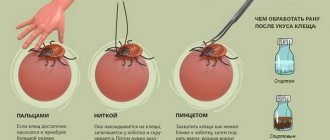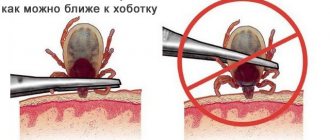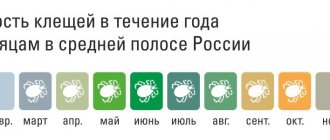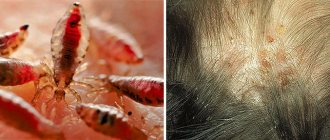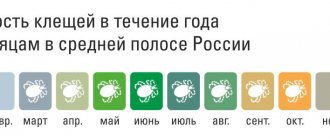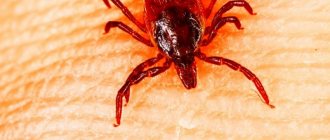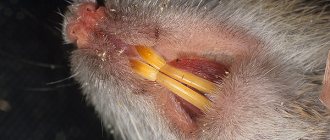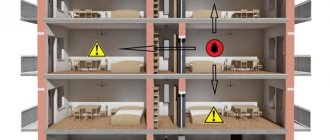Epidemiological situation in Izhevsk
According to Rospotrebnadzor, only every 100th resident of the republic is vaccinated against encephalitis in Udmurtia. And the active season for ticks begins in April. Every year in April-May, city services exterminate ticks in Izhevsk by treating the streets with pesticides against pests and blood-sucking parasites, for which about 330 thousand rubles are spent. The event is also held in parks and green recreation areas of the city.
On a note!
According to biologists, the epidemiological season of tick activity begins immediately after the snow melts, with the peak of their activity occurring in May and early June.
From May 1 to May 15, a hotline was activated in Udmurtia, designed to inform the population about behavior in a situation where a person has been bitten by a tick, where to go and how to get vaccinated, as well as work schedules and addresses of laboratories. In Izhevsk, the hotline number is: 8 (3412) 68-82-10, 68-36-54.
The most dangerous areas of Izhevsk
According to observations from past years, the most “dangerous” places, where the number of pests is maximum, is the park named after. Kirov, park named after. Gorky, Tatarbazar districts, agricultural storage facility, Votkinskoe highway, Lipovaya Roshcha, st. Rocket, village Varaksinova, the town of Metallurgists and city cemeteries. In such places, Izhevsk residents are most often attacked by “bloodsuckers.”
In the city of Izhevsk and the suburban area, the most contaminated areas are:
- horticultural areas (58%),
- forests (25%),
- city forest belts (8%);
- cemetery zones (1.7%);
- city parks and squares (1.2%).
Appearance of the ixodid tick
The most dangerous species of the arthropod family living in Izhevsk and the Udmurt Republic is ixodid ticks (lat. Ixodoidea). There are 650 species in the world, of which the most dangerous are:
- forest or taiga species;
- dog tick;
- pasture or meadow species.
Forest tick
Typically, the size of the female parasite is 3-4 mm and exceeds the length of the male by 2 times, and when filled with blood, it increases several times and looks like a gray pea with a diameter of up to 10 mm. They live on the branches of bushes, grass stems in forest areas, near paths, where they wait for their victims.
On a note!
Ticks do not rise above 1.5 m from the ground.
After wintering, which takes place in the forest floor, when the air temperature reaches +10°C, they emerge from hibernation and go in search of food, that is, human blood and warm-blooded animals. The period of their activity occurs in April-June, and then a new rise begins in September, when the larvae emerge from the eggs.
Ticks love moist and warm weather, especially long spring or rainy summer.
Anti-tick treatment of the area
Everyone must take care and protect themselves from dangerous parasites. Sanitary and epidemiological service specialists will help treat the area with special preparations.
Are you going on a picnic or a forest walk with your family? In wooded areas in the warm season you need to be extremely careful. The main danger of such walks is ticks. These small insects usually live in tall grass and are carriers of a dangerous viral disease that affects the nervous system and leads to paralysis.
How to avoid becoming a victim of a tick and what to do if an insect bite does occur? We will tell you in detail in this article.
Diseases transmitted by tick bites
The danger of bites from blood-sucking parasites is that in their saliva they can carry pathogens of various infectious diseases:
- tick-borne encephalitis, in which the virus damages the central nervous system, which threatens the victim, in the absence of timely treatment, with paralysis of the limbs and other serious complications; after suffering from a disease, a person acquires immunity to it;
- borreliosis (Lyme disease) – transmitted by bacteria through the blood, causing inflammatory processes in the human body, negatively affecting the functioning of the cardiovascular system, joints and skin; in the absence of treatment, a transition to a chronic form, as well as death, is possible; a clear symptom of the disease is the appearance of a red spot (erythema) in the area of the bite; people who have had Lyme disease can become infected again after a 7-year break;
- monocytic ehrlichiosis - an infection caused by microorganisms of the genus Ehrlichia, affects the skin, liver, central nervous system and bone marrow, where infectious granulomas are formed;
- granulocytic anaplasmosis is an acute febrile disease, transmitted by the pathogen Anaplasma phagocytophillum, microorganisms affect neutrophils, which causes a decrease in the body’s immune defense response and provokes damage to other infections and diseases;
- some types of fevers (Astrakhan, Crimean, etc.) - manifested by the appearance of papules in the bitten area, rash, itching and severe chills, then other symptoms are possible: insomnia, headache, joint pain).
Diseases from Ticks
To identify the disease, it is necessary to check the tick for the presence of the virus and take a blood test for infection.
What does a tick look like?
The carrier of the disease is the ixodid tick.
This hardy insect survives even during sudden temperature changes and can go hungry for a long time. The danger of the carrier is that it indiscriminately attaches itself to a person, animal or bird and stays on the body from several days to 2-3 weeks, feeding on the blood of its victim. Ticks hide in tall grass and smell food from another 10 meters away. The most dangerous ticks for humans are forest (taiga) ticks. They become infected with encephalitis viruses from rodents and wild animals. The parasite transmits the virus to humans through saliva and secretions.
A tick bite is not felt by humans, so most often the pest is noticed when it has already attached itself to the skin. Parasites love to hide in the thin and delicate coverings of the human body - on the neck, under the arms, in the groin. They look like small black dots, similar to moles, slightly protruding from the surface.
An allergic reaction may also occur in the form of redness, rashes on the body and itching. If the tick falls off on its own, it is almost impossible to determine the presence of a bite, since no visible traces of the bite remain.
Where to go if bitten by a tick in Izhevsk
If you find an attached parasite on your body, you must:
- remove the tick using a special device, tweezers or strong thread, trying to keep it alive;
- put in a container (preferably a glass jar with a piece of damp cotton wool, which will help prevent the parasite from drying out) and close with a lid;
- if you do not immediately take the tick for analysis, it is better to place the jar in the refrigerator;
- go to the clinic for medical help to prevent the disease;
- submit the tick to the laboratory for analysis.
List of laboratories in Izhevsk where you can submit a tick for analysis:
- FBUZ "Center for Hygiene and Epidemiology in the Udmurt Republic" 8.30-18.00, on weekends and holidays - 9.00-18.00. Izhevsk, st. Lenina, 106. Tel.. Conducts tests for the presence of viruses: encephalitis, borrelia, ehrlichia, WNV virus and anaplasma.
- Center for Hygiene and Epidemiology for the Urals, Izhevsk, st. Kirova, 46. Tel..
- Center for Hygiene and Epidemiology for Railway Transport, Izhevsk branch, Izhevsk, st. Druzhby, 6. Tel..
- Republican Vaccine Prevention Center Izhevsk, st. Petrova, 6. Tel. +7 (3412) 313-314. Acceptance of ticks for analysis is done for a fee and is carried out in the laboratory of hygiene and epidemiology.
- BUZ UR "Republican Clinical Infectious Diseases Hospital of the Ministry of Health of the Urals", emergency room. Works around the clock. Izhevsk, st. Truda, 17. Tel. 21-92-24
They accept ticks for analysis free of charge for WWII veterans, widows of WWII participants, heroes of labor (if they have an identification card). For others, the analysis is carried out for a fee:
- 90-140 rub. – it’s worth getting a tick
- 280-430 rub. – analysis for encephalitis;
- 430-485 – for borreliosis;
- 490-520 rub. – for ehrlichiosis and anaplasmosis
Prevention of tick-borne encephalitis
Always take extra precautions when walking in the forest. Use protective sprays and aerosols that repel insects in advance. After a walk in nature, be sure to check your entire body for foreign objects. If you notice a fever or a sharp deterioration in your health, consult a doctor immediately.
Always take extra precautions when walking in the forest. Use protective sprays and aerosols that repel insects in advance. After a walk in nature, be sure to check your entire body for foreign objects. If you notice a fever or a sharp deterioration in your health, consult a doctor immediately.
Blood tests
In addition to the results of a tick test for viruses, experts advise (even if the result is negative) to donate blood from the cubital vein, which will help more accurately diagnose the presence of the disease. The analysis determines the presence of antibodies of 2 classes (IgM and IgG) in the body of a bitten person. Immunoglobulins M are always the first to react, which can indicate a recent infection.
Blood test
Immunoassay is carried out in several stages:
- 10 days after the bite – for encephalitis and borreliosis for PCR testing;
- after 14 days – for immunoglobulins M for encephalitis;
- after 2 weeks - analysis for IgM and IgG antibodies to borreliosis;
- in 3 months – analysis when the peak concentration of antibodies to borreliosis occurs.
All tests after a tick bite are carried out in the above-mentioned laboratory of the Center for Hygiene and Epidemiology of the Urals.
Vaccination against encephalitis
In order to completely protect people from the risk of contracting such serious diseases as encephalitis and others, it is necessary to get vaccinated against tick-borne encephalitis on time. Doctors recommend carrying it out in the fall so that the human body can develop the necessary antibodies to the virus within six months.
On a note!
Vaccination against encephalitis is carried out in 3 stages with 3 doses with an interval of 21 days, the latest date for starting injections is February. With proper vaccination, the guarantee of protection against the encephalitis virus is 91-97%.
If you come in with a tick bite in the spring, then it is necessary to undergo emergency prevention. It is done using an injection of immunoglobulin in the first 3 days immediately after the bite. Experts recommend that if you find a tick on your body, carefully remove it, place it in a glass container and bring it to the laboratory for examination.
It is known that in addition to encephalitis, blood-sucking insects are capable of transmitting other severe infectious diseases (borreliosis, anaplasmosis, etc.).
Vaccination against encephalitis is carried out at the Republican Vaccine Prevention Center. St. Petrova, 8. Tel. +8 (3412) 313-314.
Vaccine prices:
| Vaccine name | Cost, rub. |
| Encevir, sorbed liquid, produced in Russia | 670 |
| Klesch-E-Vac (Russia) | 670 |
| Dry vaccine (Russia) | 680 |
| FSME-Immun Inject for adults (Austria) | 1400 |
| FSME-Immun-Junior for children (Austria) | 1100 |
| Encepur (Germany) for adults | 1400 |
Vaccines against encephalitis
The first signs of encephalitis
The incubation period of the disease lasts from several days to 2 weeks. Sometimes the first symptoms of the disease may appear only a month after the tick bite.
Often a tick bite goes unnoticed. At first, the parasite on the skin resembles a mole, and when it is sucked off, a small red spot remains. On the second day, redness and itching may occur. If the wound gets infected, suppuration may begin.
First stage of the disease:
Increased body temperature. Usually the temperature reaches a dangerous 38-39°; less often, a clinical course of encephalitis is possible, in which the temperature does not rise above 37-37.5°.- Muscle and joint pain. They are similar to the sensations after heavy physical exertion, and headaches are often present.
- General weakness. The pathology is accompanied by intoxication of the body, nausea and vomiting, poor health, and loss of appetite. Also, the first stage is characterized by a decrease in blood pressure, the occurrence of tachycardia, enlarged lymph nodes, and dizziness.
The first phase of the disease can last from 2 to 10 days. Between phases it can take from several hours to several days. Sometimes encephalitis occurs in only one phase - the first or second, and in some cases the clinical course is characterized by the presence of symptoms of both stages simultaneously.
The second stage of the disease occurs in 20-30% of cases. At this time, damage to the central nervous system occurs.
Symptoms of the onset of the second phase of the disease:
- Rigid neck – deterioration of motor activity. That is, a person cannot tilt his head forward and bring his chin to his chest.
- Sensitivity to bright lights and loud sounds.
- Restriction of motor activity up to paralysis.
- Impaired consciousness, hallucinations, incoherent speech.
- Coma.
The duration and manifestation of symptoms in different phases depends on the form of encephalitis: Western, Siberian or Far Eastern. The Western form is considered the mildest and rarely leads to serious complications. Most often found in Europe.
Far Eastern encephalitis is considered the most dangerous. It begins with severe fever, nausea, general weakness and intoxication of the body. Damage to the central nervous system occurs within 3-5 days. The patient's breathing and blood circulation are impaired, brain function is damaged, which can lead to death.
In some cases, tick-borne encephalitis becomes chronic and appears in periods of exacerbation.
A person who has recovered from encephalitis receives lifelong immunity. With a second bite, infection is impossible. But do not forget that insects carry many different viral diseases, so the risk of infection cannot be excluded.
